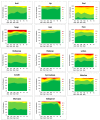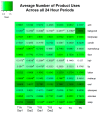Personal Care Product Use in Pregnancy and the Postpartum Period: Implications for Exposure Assessment
- PMID: 26751460
- PMCID: PMC4730496
- DOI: 10.3390/ijerph13010105
Personal Care Product Use in Pregnancy and the Postpartum Period: Implications for Exposure Assessment
Abstract
Concern regarding the potential for developmental health risks associated with certain chemicals (e.g., phthalates, antibacterials) used in personal care products is well documented; however, current exposure data for pregnant women are limited. The objective of this study was to describe the pattern of personal care product use in pregnancy and the post-partum period. Usage patterns of personal care products were collected at six different time points during pregnancy and once in the postpartum period for a cohort of 80 pregnant women in Ottawa, Canada. The pattern of use was then described and groups of personal care product groups commonly used together were identified using hierarchical cluster analysis. The results showed that product use varied by income and country of birth. General hygiene products were the most commonly used products and were consistently used over time while cosmetic product use declined with advancing pregnancy and post-delivery. Hand soaps and baby products were reported as used more frequently after birth. This study is the first to track personal care product use across pregnancy and into the postpartum period, and suggests that pregnant populations may be a unique group of personal care product users. This information will be useful for exposure assessments.
Keywords: concurrent use; exposure; personal care products; pregnancy; reproductive health; use patterns.
Figures











References
-
- Health Canada Consumer Product Safety. [(accessed on 18 December 2015)]. Available online: http://www.hc-sc.gc.ca/cps-spc/pubs/indust/cosmet_drug_guide-drogue-ref/....
Publication types
MeSH terms
Substances
LinkOut - more resources
Full Text Sources
Other Literature Sources
Medical

